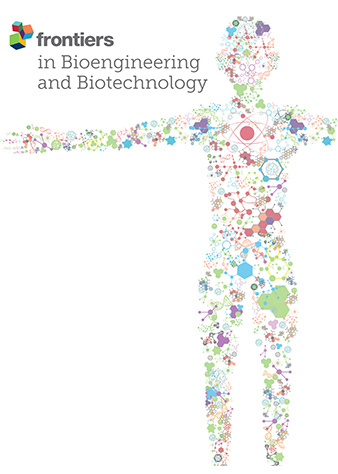合成用于实验性癌症放射治疗的三金属铁-硼内核和金外壳纳米粒子
IF 4.8
3区 工程技术
Q1 BIOTECHNOLOGY & APPLIED MICROBIOLOGY
引用次数: 0
摘要
癌症是一个重要的临床问题,而且在全球范围内持续增长。在过去几十年中,许多类型癌症的死亡率几乎没有变化,治疗方案也很有限。恶性胶质母细胞瘤(GBM)就是一个突出的例子,它对周围健康脑组织的浸润程度很高,死亡率和发病率极高,损失的生命年数也是所有癌症中最多的。在过去几十年中,大量的研究工作都未能改善这些结果。硼俘获中子疗法(BNCT)是一种实验性放射疗法(RT),为目前所有疗法都失败的患者带来了最大的希望。硼俘获中子疗法涉及硼在中子束作用下在细胞内释放阿尔法和锂离子粒子,因此其成功与否关键取决于癌细胞内硼原子浓度的高低。苯丙氨酸硼(BPA)是最常用的硼原子递送化合物,但这种小分子化合物很难在细胞内实现高浓度的苯丙氨酸硼,这也是 BNCT 取得较好疗效的绝对限制因素。我们的方法侧重于以新型三金属核壳纳米粒子的形式递送高浓度且稳定的硼原子,核内结合了用于 BNCT 的硼和用于磁性靶向的铁,金壳用于靶向治疗肽的稳定性和附着。研究的目标是比较不同的合成变量,以形成这些核壳粒子,并通过氧化还原-反金属作用将尽可能多的硼加入核中。通过岛状生长,在核心周围形成了部分金壳,Fe/B 摩尔比为 0.64,硼的掺入量较高。本文章由计算机程序翻译,如有差异,请以英文原文为准。
Synthesis of trimetallic iron-boron core and gold shell nanoparticles for experimental cancer radiotherapy
Cancer is a significant and constantly growing clinical problem all over the word. For many types of cancer there has been little change in mortality rate of CRC in the past decades and treatment options are limited. A striking example is malignant Glioblastoma (GBM) which exhibits a high degree of infiltration of surrounding healthy brain tissue, extremely high mortality rate, morbidity and most life-years lost of any cancer. Considerable research efforts in the last several decades have failed to improve these outcomes. Boron Capture Neutron Therapy (BNCT) is an experimental radiotherapy (RT) that shows the best hope for the patients for whom all current therapies fail. BNCT involves the intracellular release of alpha and Li-ion particles from boron in response to neutron beam and therefore its success is critically dependent on achieving high intracellular concentrations of boron atoms within the cancerous cells. Boron phenylalanine (BPA) is the most used compound to deliver boron atoms, but achieving high intracellular concentration of BPA is difficult with this small molecule compound and is an absolute limiting factor for the better outcome of BNCT. Our approach focused on a delivery of a high and stable concentration of boron atoms in a form of novel trimetallic core-shell nanoparticles, combining boron for BNCT and iron for magnetic targeting in the core, and a gold shell for stability and attachment of targeting therapeutic peptides. The research was targeted towards comparing different synthesis variables to form these core-shell particles and incorporate as much boron into the core as possible via redox-transmetalation. Partial gold shells were formed around the core via island growth with a molar ratio of Fe/B of 0.64 and high incorporation of boron.
求助全文
通过发布文献求助,成功后即可免费获取论文全文。
去求助
来源期刊

Frontiers in Bioengineering and Biotechnology
Chemical Engineering-Bioengineering
CiteScore
8.30
自引率
5.30%
发文量
2270
审稿时长
12 weeks
期刊介绍:
The translation of new discoveries in medicine to clinical routine has never been easy. During the second half of the last century, thanks to the progress in chemistry, biochemistry and pharmacology, we have seen the development and the application of a large number of drugs and devices aimed at the treatment of symptoms, blocking unwanted pathways and, in the case of infectious diseases, fighting the micro-organisms responsible. However, we are facing, today, a dramatic change in the therapeutic approach to pathologies and diseases. Indeed, the challenge of the present and the next decade is to fully restore the physiological status of the diseased organism and to completely regenerate tissue and organs when they are so seriously affected that treatments cannot be limited to the repression of symptoms or to the repair of damage. This is being made possible thanks to the major developments made in basic cell and molecular biology, including stem cell science, growth factor delivery, gene isolation and transfection, the advances in bioengineering and nanotechnology, including development of new biomaterials, biofabrication technologies and use of bioreactors, and the big improvements in diagnostic tools and imaging of cells, tissues and organs.
In today`s world, an enhancement of communication between multidisciplinary experts, together with the promotion of joint projects and close collaborations among scientists, engineers, industry people, regulatory agencies and physicians are absolute requirements for the success of any attempt to develop and clinically apply a new biological therapy or an innovative device involving the collective use of biomaterials, cells and/or bioactive molecules. “Frontiers in Bioengineering and Biotechnology” aspires to be a forum for all people involved in the process by bridging the gap too often existing between a discovery in the basic sciences and its clinical application.
 求助内容:
求助内容: 应助结果提醒方式:
应助结果提醒方式:


